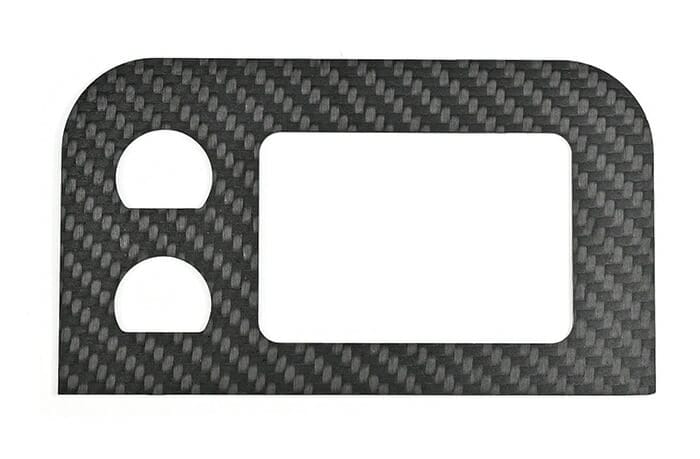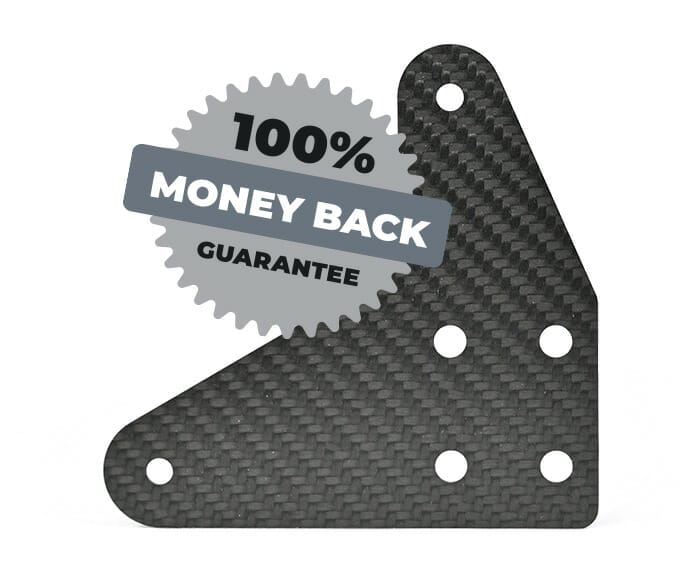Our carbon fiber is sturdy, lightweight, and comes in a clean, double-sided matte finish. Engineers and designers across many industries turn to us for durable, affordable waterjet cut carbon fiber parts.
Instant quote
A: 1″ x 2″
B: 23″ x 44″
.040″ (1.02mm)
.063″ (1.60mm)
.079″ (2.01mm)
.118″ (3.00mm)
.157″ (3.99mm)
.197″ (5.00mm)

Our sleek 2×2 twill weave, standard carbon fiber is perfect for low weight, high strength applications. It is popular in the aerospace and automotive sector due to its amazing strength-to-weight ratio. We choose to offer standard 2×2 carbon fiber for the marriage of tensile strength and rigidity which other weaves can’t provide. The 2×2 twill weave carbon fiber is also considerably stronger than steel, while also being a fraction of the weight.
Carbon fiber is a popular composite in industries where safety is a top priority due to its high rigidity and ability to absorb impact energy. Here at SendCutSend, our carbon fiber cutting services can provide truck dashboards, airplane switch panels, and combat robotics protective paneling made to your specifications.
Our carbon fiber has the same matte finish on the front and back sides.
We guarantee awesome quality parts. If you’re not 100% happy, we’ll give you a refund or remake on the spot – no questions, no hassle.

SendCutSend offers Carbon Fiber in six thickness options: .040″ (1.02mm), .063″ (1.6mm), and .079″ (2.01mm), .118″(3.00mm), .157″(3.99mm), and .197″(5.00mm)
With SendCutSend’s Carbon Fiber offering, you can get parts instantly quoted if they fall between 3″ x 3″ and 23″ x 44″.
You can add the following services to your Carbon Fiber parts:
Waterjet Cutting
We accept .ai, .dxf, .dwg, .eps, .stp, and .step
Customize one of our simple parts templates
Send us a sketch or template and we'll create a file and send you a cart.
Carbon fiber composite sheet is created by laying woven carbon fibers in an epoxy resin matrix and curing them under heat and pressure. The result is a rigid laminate with exceptional stiffness, strength, and low weight, far outperforming metals on a weight-for-weight basis.
It’s used anywhere engineers need structural strength with minimal weight: from aerospace and automotive to sports equipment and robotics. At SendCutSend, carbon fiber is precision cut on industrial waterjets, making it easy to design and order custom parts in this high-performance material.
Carbon fiber is known for its strength-to-weight ratio and dimensional stability. While aluminum is strong and ductile, carbon fiber is stiffer and lighter, but not designed to bend or stretch.
Typical properties of cured laminate include:
These qualities make it ideal for lightweight, load-bearing panels, brackets, and housings.
Yes, but not with traditional shop tools. Abrasive blades or saws can cut carbon fiber, but they often cause fraying, delamination, or excessive dust.
Because carbon fiber is a layered composite, cutting methods can introduce defects if not done correctly:
With waterjet cutting, these issues are minimized. The abrasive jet slices through without heat, producing clean edges with minimal fraying. Parts arrive ready to use, though it’s best to handle edges carefully since they can be sharp.
At SendCutSend, we hold ±0.009″ cutting tolerance on carbon fiber sheets.
For detailed specs, see the carbon fiber specifications section on our material page.
No—carbon fiber laminate cannot be bent or formed like sheet metal. Attempting to bend it will cause cracking or delamination. Complex 3D shapes must be molded during the layup process, not after curing.
For projects requiring bends, consider pairing carbon fiber flat panels with bent metal brackets (such as 5052 aluminum or 304 stainless steel) for hybrid assemblies.
When designing for carbon fiber cutting:
These practices ensure stronger, longer-lasting parts and reduce the risk of damage at cut edges.
Carbon fiber itself does not rust or corrode, but it can degrade under certain conditions:
For indoor or occasional outdoor use, carbon fiber lasts many years. For permanent outdoor exposure, a UV-stable clear coat is recommended.
Because of its strength and lightness, carbon fiber is common in:
If your project needs stiffness and weight savings, carbon fiber is often the best choice.
DIY cutting of carbon fiber is possible with diamond-coated blades or carbide tools, but it comes with hazards:
Outsourcing to SendCutSendensures:
For prototypes, performance parts, and production runs, outsourcing is almost always safer, faster, and more reliable.
We use abrasive waterjet cutting to process carbon fiber sheets. This method avoids the heat and burning issues of lasers while preserving the integrity of the composite.
Simply upload your design to our instant quoting system to get started.
Carbon fiber offers an unbeatable combination of low weight, high strength, and stiffness, making it ideal for drones, vehicles, aerospace, and robotics. While difficult to cut with DIY tools, SendCutSend makes it easy by providing precision waterjet cutting, fast turnaround, and consistent quality. If your design calls for strong, lightweight panels with a sleek black finish, carbon fiber is one of the best materials available.